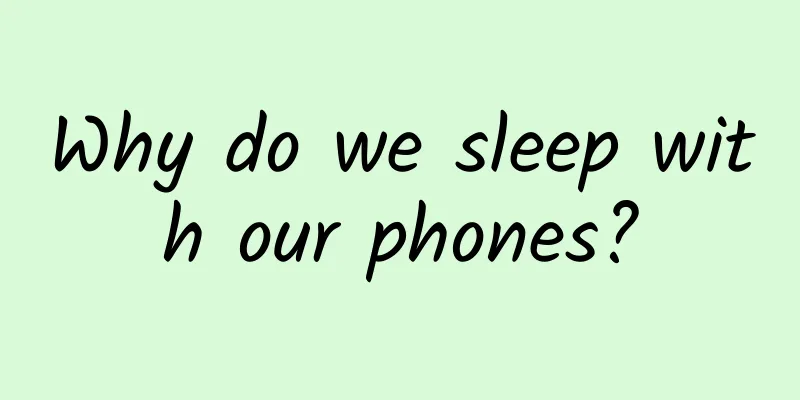Why do we sleep with our phones?

|
Think about this morning. Did you reach for your phone as soon as you woke up? Was it next to your bed? Or under your pillow? Did you set an alarm with it? What was the first thing you did after turning off the alarm? Did you check your email, or check your Facebook or Instagram account? If none of these describe you, and you keep your phone away when you go to bed, you are definitely in the minority. To avoid missing calls, texts, or other updates, 44% of mobile phone users keep their phones within easy reach when they sleep. This phenomenon is most pronounced among people aged 18-34, but it is also common among older mobile phone users. Social control (FOMO) has spread to our bedrooms. This may not be surprising to you, but your reaction is also expected. The boundaries between private and public space have always been in flux, and as a result, there is no clear demarcation between the norms of behavior in these two environments. So perhaps we are used to (and hope for) common ground between the two. If you think about the definition of home, you can see the back and forth. Its diversity shows that even the same time and place can bring different feelings. These differences are related to personal economic and social inclinations. Home can be a villa, a cafe, a park, or an underground passage. As long as you meet with your close ones, you can feel at home no matter where you are. Despite this variability, home still symbolizes privacy and freedom, thanks to the Victorian era. With urbanization and industrialization, the growing bourgeoisie began to build the home into a castle away from business and work. They divided their lives into public spaces for business and socializing, and private spaces for handling family affairs, communicating with family members, and expressing their true feelings. However, there are exceptions. For example, it is not uncommon for businessmen to live in the place where they work. And for many people with poorer economic conditions, private space is too luxurious, and they often feel at home in public spaces. The Victorian middle class created their own exclusive leisure areas. So what did people do at home? Home is where you can eat, play, be affectionate with loved ones, and lose your temper without the need to be careful or polite as you would in public. Dickens captured this vividly when he described Fred's Christmas party in A Christmas Carol. Fred and his guests played all kinds of fun games to pass the time after dinner. They talked about Scrooge and even spread some gossip about him. They could only do this here. This was their place. In public places, the rules of behavior reflect the way most people expect to feel; at home, the rules and etiquette do not necessarily match these norms. The word "home" is very meaningful. Home is where we can be our truest selves. Only those closest to us can come here, and everything here is of our own choice. Home is the place we rush to for shelter after a bad day, and the place where we need to rest when we need to be. In the morning, we are reluctant to leave. It is ours, and we have the final say. But we don’t always stay in the comfort of our own homes; there are jobs to do, errands to run, doctor’s appointments to go to, and friends to meet, all of which require us to leave our homes. But when we go out, we still bring a little bit of home with us. Yes, we spend time reading, listening to music, or watching movies, and these things extend our autonomy and private space into public space. The domestication of public space is the process by which things that were previously only done in private spaces become acceptable in public. For example, eating outside was once a symbol of the lower class. In medieval cities, poorer families did not have kitchens, so they would take their meat to street vendors to cook. Whether or not we ate indoors was one of the criteria for the distinction between public and private, but today we can eat outside as if we were at home. For example, we can invite a group of friends and family to dinner, but only those of us will be eating the dishes we ordered. So, although we are in a cafe or restaurant and there are strangers eating with us, we are still only interacting with the friends at the table. In this way, we encode similar private behaviors into public places. It’s like putting Fred’s party on stage, and we just watch them perform (or perform our own show). This is not a new phenomenon. For example, with the popularization of automobiles, people have taken their homes on the road. Cars are our mobile homes. Think about it: almost everything we do at home can be done in the car, such as eating, entertaining, making out, and sharing our hearts. But simpler things like picnic baskets can also make us feel familiar from the unfamiliar. However, the force is always mutual, and we have always tried to maintain the inviolability of the home, but this has been subtly influenced by external factors. One of the characteristics of the home is convenience. The conveniences we are most exposed to include ordering food and having it delivered to our home, renting videos, shopping online, and working from home. These things that once required us to go out can be enjoyed at home with help. However, this requires our private space to give way to the public space. For example, ordering takeout means that we miss the joy of cooking. Such a meal still retains its social element, but it is less private because the outside world is integrated into our private sphere. Renting a DVD also allows us to experience the outside world at home. This is called the integration of the outside world into our private sphere. Shopping and paid labor are traditionally activities in the public sphere, and doing these things at home makes the boundaries between the public and private even more blurred, gradually eroding the boundaries we have worked so hard to draw. Of course, technology has greatly facilitated this convenience. Social media allows us to keep in touch with friends and family, and portable devices that can listen to music, watch movies and play games provide us with hours of entertainment. What about food? Of course, there are an app or two to help you solve this problem, and you don’t even need to talk to others. All of this is cleverly integrated into our mobile phones, which we carry with us wherever we go and at home. It brings convenience to us in both public and private spaces: 70% of mobile phone users use their mobile phones to communicate or check instant messages, including scheduling meetings (41%), looking up information (27%), and checking traffic conditions (20%). But convenience comes at a price: connectivity. Staying connected to friends and family means they can reach you from the sidewalk to your living room. We’ve learned that there are problems: If we don’t respond to texts, we’ll probably get a complaint, so we keep our phones with us even when our family members complain that we spend too much time on them. This can also dilute the idea of home, because people are forcing their way into your space, whether you want them to or not. This conflict exists in both public and private spaces, blurring the lines between the two, and it’s what has brought us to today’s convenience. With today’s convenience, we’ve come to a new definition of home. With these conveniences, we can tailor our experiences to reflect our personal preferences: storing music on portable devices allows us to have our own music, whether happy or sad, to accompany us; ordering takeout allows us to enjoy our favorite food; shopping online makes life much easier when we have free time. With these conveniences, the outside world has also been integrated into our private space. And once they are integrated, they follow us everywhere – including our bedrooms. We sleep with our phones because they are so important to our lives and new inventions. Our phones are great tools, so even if we sometimes choose to silence them or turn them off, we always have them with us because they bind us to a huge network of people and devices. We are in them all the time, and they shape our living space. Do you sleep with your phone next to you? When was the last time you opened up your private space with your electronic device in a public place? As a winner of Toutiao's Qingyun Plan and Baijiahao's Bai+ Plan, the 2019 Baidu Digital Author of the Year, the Baijiahao's Most Popular Author in the Technology Field, the 2019 Sogou Technology and Culture Author, and the 2021 Baijiahao Quarterly Influential Creator, he has won many awards, including the 2013 Sohu Best Industry Media Person, the 2015 China New Media Entrepreneurship Competition Beijing Third Place, the 2015 Guangmang Experience Award, the 2015 China New Media Entrepreneurship Competition Finals Third Place, and the 2018 Baidu Dynamic Annual Powerful Celebrity. |
<<: China Telecom's future goal: popularize "20M broadband"
>>: Sony suffered a great loss due to "mountaintopism"
Recommend
Getting started with operations: How to build a data analysis knowledge system from 0 to 1
Data analysis is ubiquitous in operational work. ...
A small action before going to bed may actually keep you away from Alzheimer's disease?
Perhaps, you who live in the city always enjoy be...
O2O transforms traditional service industry in many ways, taking hairdressing as an example
The hairdressing industry is a basic need for mos...
A comprehensive analysis of Luckin Coffee’s private domain traffic operations
1. Luckin Coffee Private Domain Traffic Case Case...
What can you see 400 million kilometers from Earth? A long comic strip reviews the "Height of China" in 2021
Source: People's Daily Weibo, Produced by: Go...
Why do many people listen to their voice messages again after sending them?
Have you noticed that many people around you will...
6 major features of short video marketing promotion!
Why is short video marketing so popular? What are...
How to attract traffic to Tik Tok? Practical tips from registration to popularity!
There are many channels for attracting traffic no...
Today is the Winter Solstice | Snow is falling outside the window in the dead of winter, and the house is warm and cozy
"The stars turn and the frost spreads overni...
"Poet Academician" Wang Yuming: Always have a pure heart
He is an expert in mechanical design and theory, ...
Unboxing the new Inphic i5 quad-core phone: There is such a unique and beautiful little bun in the world
The packaging box was ordinary, but when I saw th...
Migraine only hurts on one side of the head? NO! Here are 7 tips to help you get rid of the headache curse
There is a kind of pain that makes people unforge...
Consumer demand still exists, home appliance companies focus on the third and fourth tier markets
With the influence of national policies, the spee...
Without tens of millions of users, how can the value of To B operations be reflected?
Compared with To C operations , To B operations a...
How did Gree mobile phones kill Xiaomi?
On June 14, Gree's third-generation mobile pho...









